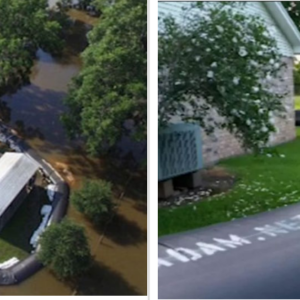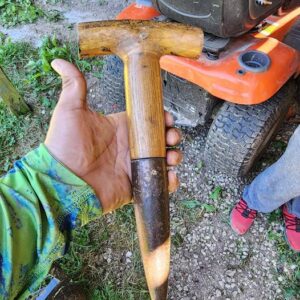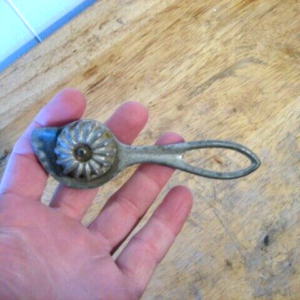HERE ARE SOME OF THE ANSWERS:
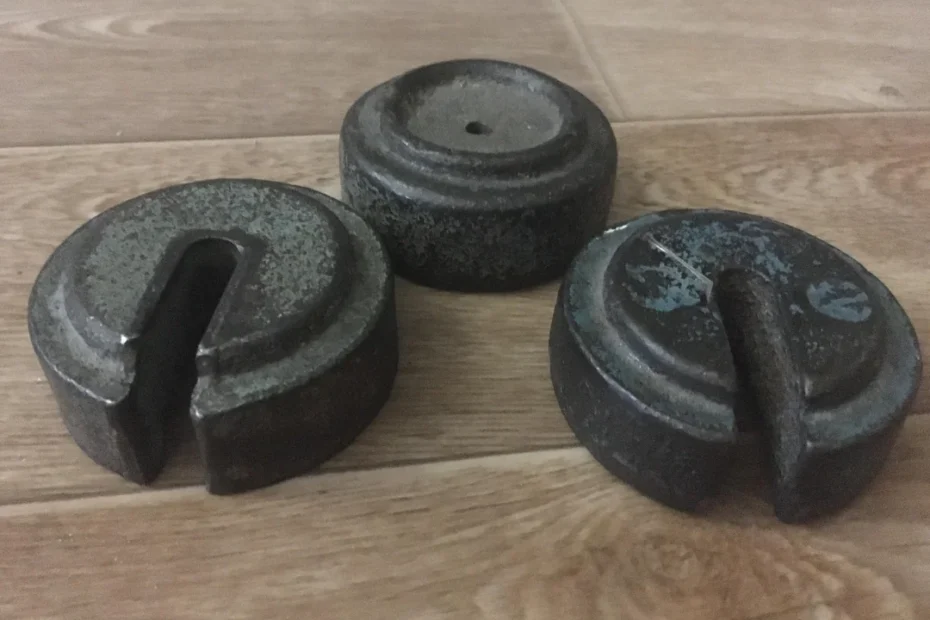
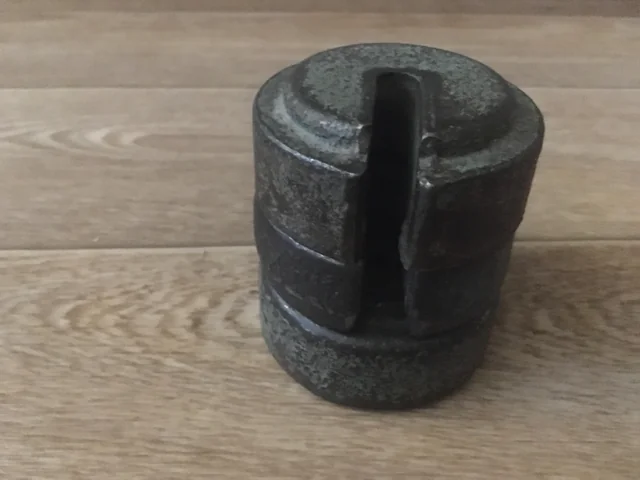
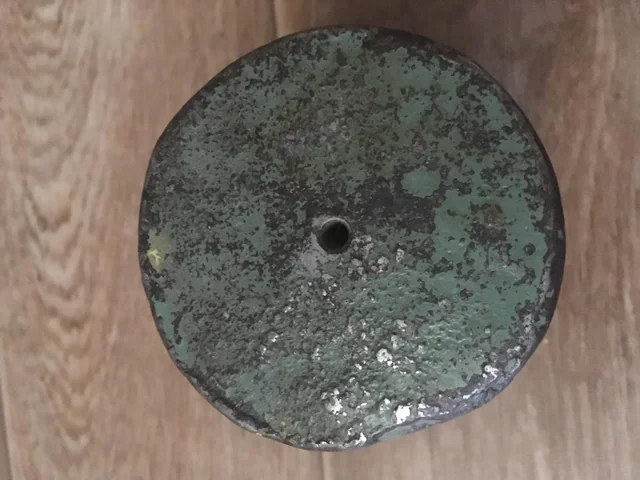
- Slotted weights are scale tip or counter weights. Added to the end of the beam that you read, they increase the scale capacity by the amount shown on the weight. When you read the beam, you need to add the ratio amount stamped into the weight. Depending on the scale, these can have two different weights stamped into them as the scale will have two different load pans (typically a union scale with a platform and a scoop). These weights will also have an adjustment hole with lead in it. Stamped into the lead will be the sealers mark. If the lead is missing, the weight is probably not accurate. The one with the hole is the balance box that also hangs off of the beam. It is intended to be installed at all times and will contain lead shot (or similar) that is used as part of the scale zero balance procedure. It is typically mounted with a long rod that hangs from the tip of the beam. The rod is missing in your picture and it doesn’t appear to have an adjustable portion. It almost looks like a homemade replacement. There can be another part of the zero balance on the short arm of the beam and is often a movable weight (on a screw), but is sometimes also a balance box with or without a movable weight. I spent many years as the guy setting these up. Hurts me that an archaeologist commented on finding these. I’m not that old! They are still in use today. There is some credibility to the traction weight comments as well. These weights are often used in other systems that require known weights as they are relatively cheap and were easily available. Also, upon looking closer to your picture, the weights don’t appear to have ratio values stamped into them. This is unusual and would lend even more credence to an alternate use. Bagging systems come to mind. While some of these are technically scales, not all had readouts. These machines were used to fill large bags to a desired weight semi-automatically.
- We used these in our physics laboratory at school, take a wire, tie one end up to something rigid on one side of the table, take it over a pulley on the end of the table and tie the weights to it. Add the weights to increase the tension and use a ruler to measure the amplitude of the wave when you strike the wire. You now have an apparatus to measure the effect of tension on a standing wave. We did have specialized equipment for it though.
- My kids did a spaghetti bridge building competition in elementary school and I brought a bunch of these to test the bridge strength. Surprisingly most of the bridges held all of the weights and I had to go back and get heavier test weights.
- Looks like traction weights used in hospitals
- These look like weights used with circular sock knitting machines. They were in their vogue around 1910-1920, but are still made today for hobbyists. They are used to hang to keep tension on the work and avoid dropped stitches. There would be a hook extending upward through the bottom one to attach to the cast-on bonnet used to start the work.
- Scale weights. My father’s company had one when I was a kid. When he would bring me to work, I and my brother would weigh ourselves, heavy stuff, trash, et cetera; and would add and remove these weights from the balance.
- I’ve seen old weightlifting equipment with weights like these.
- I’ve seen them used to weigh down pop-up canopies so they don’t blow away. Great for insurances you’re not able to put down a stake (concrete, hard land, loose soil/sand). But may have been repurposed for this use and wasn’t originally sold/made to go with those canopies
- Could be for Buck’s traction. We use weights like that to counter act the muscle tightness resulting from hip fractures. Patients are placed in a boot then strung up to these weights.
- These are the counter-weights you use with a large sliding warehouse type door on a track. There’s a rope that comes out of the top of the door and goes over a pulley and hangs down. The weights hang on that rope and make it easier to open/close the door.
- They are weights that go around the base of a post, usually for a tent or shade structure. Like the tents used at festivals or farmers markets.’
- In the military I would use these as an upper and lower tolerance for trigger pulls. One set would be the lower end of the trigger pull (should not go off) the other set would be the upper end (should go off). Different guns had different trigger pull weights so we’d have to switch up weights.
- Weights for a Dubied Knitting machine, I have a few. The one with the hole should have a rod with a hook on the end
- These are scale weights. I used to use them to weigh propane tanks at my old job. The one with the hole usually has a thin metal rod in it and is a counterweight. the two cutoff ones are supposed to stack on top and are used for different weights
- Yes these are slotted weights. The one with a hole in the center goes on the bottom of the rod, the slotted ones are stacked on top of it. Commonly used in brinell machines used to make an impression in metal which is then measured and calculated using a conversion chart into a hardness number.
- These look like weights for testing trigger pull resistance in a gun. Usually has a rod that goes through the weight with the hole, then the slotted weights can be added on top. We had minimum trigger pull resistance regulations for the weapons, especially during competitive shooting. I used to adjust my spring tension so I was at the bottom of the allowable trigger pull resistance… for more accurate shooting. This is a newer style… but I had the exact weights you picture when I was an Armory tech in the US Marines in the 1990s.
- Scale weights! Remember going to the bodega in Cuba as a kid and the lady would use that
- I will give a counter argument to the popular “Scale Weights” suggestion.They are not scale weights, because they’re all the same size. Scale weights would be many sizes.They are the counterweights you put on a telescope mount, to balance it out so the drive motors can turn the scope with low effort. They are all the same size because you can slide them up and down the arm that is for the counterweights.My dad has… a lot … of telescopes.
- I’ve got these for fire door counterweights, smaller ones for shop lights and old roll up doors in the theatre I work for. Oh, and for a two-story paint rack on the back wall. Usually marked with maker and weight.
- They remind me of the weights we used to use when we put someone with a hip fracture on Buck’s traction to hold the bones and muscles in place until the person went to surgery.A brace went around their leg and had ropes on it that went around a pulley and the weights hung on the other side of the pulley.
- They remind me of the weights we used to use when we put someone with a hip fracture on Buck’s traction to hold the bones and muscles in place until the person went to surgery. A brace went around their leg and had ropes on it that went around a pulley and the weights hung on the other side of the pulley.

